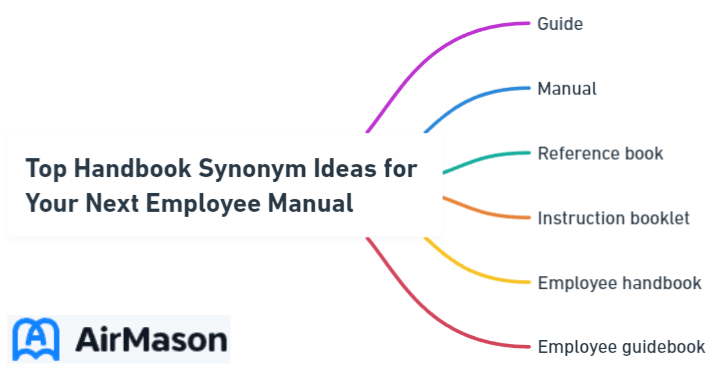
When you require a handbook synonym for an employee guide or policy document, terms like ‘manual’, ‘guidebook’, and ‘reference book’ emerge as prime candidates. This article dives into these alternatives, outlining when and how to use each to effectively communicate in a professional setting.
Key Takeaways
- Employee handbooks, manuals, and reference books, while similar in purpose, differ in detail and specificity. Guidebooks offer a comprehensive overview, manuals deliver detailed instructions, and reference books provide quick, topic-specific information.
- Effective handbooks are more than policy collections; they set expectations, reinforce company culture, ensure legal compliance, and prioritize employee well-being through clarity and accessibility.
- Modern alternatives to traditional handbooks include digital and interactive platforms that offer real-time updates, personalized content, and media-rich, engaging elements that cater to diverse learning styles.
Updated Employee Handbook
The updated Employee Handbook reflects our commitment to providing clear guidelines and support for our employees. With the “Updated Employee Handbook,” we aim to streamline policies and procedures to enhance clarity and promote a positive work environment. This revised handbook incorporates feedback from employees, legal updates, and best practices in the industry. By ensuring that the “Updated Employee Handbook” is easily accessible and comprehensible, we empower our team members to understand their rights, responsibilities, and opportunities within the organization. Additionally, this update underscores our dedication to fostering a culture of transparency, fairness, and mutual respect. We encourage all employees to familiarize themselves with the contents of the “Updated Employee Handbook” and reach out to HR for any clarification or assistance needed.
Exploring Synonyms for “Handbook”

A handbook is a professional lifeline that helps steer the employee journey, from onboarding to everyday tasks. You might have come across terms like ‘guidebook’, ‘manual’, and ‘reference book’, each carrying subtle differences and unique nuances. These terms, just as historical ones like ‘Baedeker’ and Latin phrases like ‘vade mecum’, all serve the same purpose – to guide, instruct, and reference. But what sets them apart?
- A guidebook is typically used for travel purposes, providing information and recommendations for tourists.
- A manual is a detailed set of instructions or guidelines for operating a specific device or system.
- A reference book is a comprehensive source of information on a particular subject, often used for research or study.
While these terms may have different connotations, they all share the common goal of providing guidance and information.
Guidebook: A Comprehensive Resource
Consider a guidebook as the company’s roadmap. It’s the comprehensive resource that introduces employees to the company’s culture, policies, and procedures. From the heart of San Diego to the bustling streets of New York, a guidebook ensures that employees, irrespective of their location, are aware of the company’s rules and expectations.
It provides clear instructions on everything from daily tasks to handling complex situations, integrating employees into the workplace ethos and values. Essentially, a guidebook serves as the comprehensive resource for all company-related information.

Manual: Detailed Instructions and Procedures
Unlike a guidebook which provides an overview, a manual delves into the specifics. It’s like a hands-on tutorial that provides step-by-step instructions on how to perform specific tasks, operate systems, or adhere to processes. From jury duty to military service, a manual organizes information comprehensively, ensuring employees can quickly find specific instructions without needing to consult multiple sources.
So, whether you are a new hire or a seasoned employee, you can count on the manual to help you navigate through your tasks efficiently. Note that the terms ‘manual’ and ‘handbook’ often refer to the same document type, providing detailed instructions and procedural information.
Reference Book: Quick Access to Information
In the fast-paced professional setting, having quick access to relevant information is crucial. This is when a reference book, a kind of handbook, proves useful. It offers practical guidance that speaks to employees and managers from all generations, making it a valuable tool even outside of business hours.
Imagine needing to find information about a specific company policy or procedure. Rather than scouring through countless pages of a manual, a reference book allows you to quickly locate and consult the information you need. It’s a time-saving tool that enhances productivity and enables informed decision-making.
The Role of Employee Manuals in the Workplace

An effective employee handbook is more than just a collection of company policies. This communication tool serves multiple roles in the workplace, including:
- Setting clear expectations
- Confirming company values
- Contributing to a healthy work environment
- Setting the tone of company culture
- Prioritizing employee well-being
It’s an essential resource that plays a crucial role in the success of the organization, making the proper management of company property vital.
We’ll further examine these roles.
Setting the Tone: Company Culture and Values
A well-crafted employee handbook has the power to shape company culture and influence employee behavior. It translates company policies into living principles and fosters an environment that reflects the organization’s ethical commitments. By addressing employee needs and encouraging respectful communication, handbooks contribute to a positive and cooperative workplace culture.
Moreover, handbooks provide a platform for:
- Introducing new team members to company values and communication etiquette
- Motivating team members to participate in cultural activities and turn written ethics into actions
- Establishing trust through consistency in tone and language
- Setting a foundation for inclusivity through an upfront commitment to diversity and equity.
Policies and Procedures: Ensuring Compliance
Employee handbooks play a critical role in ensuring compliance with local, state, and federal laws. They outline the company’s policies and procedures, including:
- Health and safety regulations
- Overtime rules
- Anti-discrimination policies
- Code of conduct
- Leave policies
- Performance expectations
In the case of a California employee handbook, it is essential to ensure that it adheres to the specific state regulations in addition to the federal laws. To achieve this, it is helpful to refer to employee handbook examples that comply with both state and federal laws.
These handbooks ensure that existing employees are aware of their rights and responsibilities, such as the Medical Leave Act and accessing their employee’s personnel file, as outlined in the Fair Labor Standards Act, and serve to inform employees about these important matters.
But compliance with laws is not a universal approach. Handbooks must be tailored to federal and state laws, which may involve creating separate handbooks by location or having a universal handbook with state-specific addenda.
From the sunny beaches of Santa Monica to the bustling city of San Francisco, California’s various cities require thorough research and inclusion of state-specific policies for lawful policy enforcement.
Employee Handbook for Small Business
Creating an employee handbook for small business is crucial for establishing clear expectations, policies, and procedures within the organization. This handbook serves as a valuable resource for both employers and employees, outlining important information such as company mission, values, workplace conduct, and benefits. By providing guidelines and expectations upfront, small businesses can promote consistency, fairness, and compliance with legal regulations. Additionally, an employee handbook can help foster a positive work environment and mitigate potential conflicts by clearly defining roles, responsibilities, and disciplinary procedures. Overall, investing time and effort into developing an employee handbook is essential for the long-term success and growth of a small business.
Health and Safety: Prioritizing Employee Well-being

Ensuring employee health is central to a company’s responsibility. That’s why health and safety policies are a vital part of an employee handbook. Clear guidelines on emergency procedures, including responses to fires, natural disasters, and medical emergencies, should be outlined in the handbook. This includes information on available training programs to better prepare employees.
The handbook should promote a culture of safety, encouraging employees to take personal responsibility for their environment by reporting unsafe conditions, near misses, and accidents. To support this, manuals are carefully designed to be user-friendly and accessible, ensuring that safety precautions and warnings are readily understandable to both new hires and veteran staff.
Designing Effective Employee Guides
Creating a robust employee handbook involves more than just compiling company policies. It’s about:
- Ensuring clarity
- Considering legal implications
- Keeping content current
- Making it engaging.
We’ll examine these aspects more closely.
Clarity and Accessibility: Making Information Understandable

Clarity and accessibility are key for an effective employee handbook. This means:
- Using direct, concise language
- Avoiding jargon whenever possible
- Ensuring that all employees have access to the handbook in both printed and digital formats.
Moreover, an efficient handbook:
- is well-organized
- includes visual aids, such as explainer videos, to help employees understand the material easily
- has personalized content
- has a searchable index within the handbook software to enhance user-friendliness and inclusivity, catering to a diverse workforce.
Legal Considerations: Aligning with Employment Laws
Ensuring compliance with employment laws is a critical aspect of creating an employee handbook. This requires consulting with employment lawyers and regularly updating the handbook to reflect changes in laws.
While creating a handbook, it’s important to carefully review the language used as courts may interpret handbooks as contracts. To avoid potential legal issues, include disclaimers clarifying that the at will employment relationship is maintained and that the handbook does not create a contract. This careful and measured approach ensures that your handbook is legally sound and serves as a valuable tool for both the employer and employee.
Regular Updates: Keeping Content Current
Given the ever-changing business landscape, it’s crucial to keep your employee handbook updated. Regular reviews and updates ensure that the information remains current and relevant to the employees. Consider your handbook as a living document, flexible to amendments as necessary. Any updates should be promptly communicated to employees to ensure that they are always aware of the most current policies.
However, updates should not only be about laws and regulations. As your company evolves, so should your handbook. It should reflect the changes in your company culture, align with your mission, vision, values, and adopt clear and concise language for communication. Feedback mechanisms can also be incorporated to engage employees in the handbook review process, using their input to make the guide more relevant and beneficial.
Alternatives to Traditional Handbooks
While traditional handbooks have served us well, it’s time to embrace the digital age. Advancements in technology have presented us with innovative alternatives to traditional handbooks, such as digital handbooks and interactive platforms.
We’ll examine these modern alternatives further.
Digital Employee Handbook: Leveraging Technology

Digital handbooks are more than just a trend, they represent the future. By going digital, you can make your employee handbook accessible through various platforms, from mobile apps to online platforms such as the company’s website or intranet. Unlike traditional handbooks, digital ones can be updated in real-time, ensuring that employees always have access to the most current policies.
However, the advantages extend beyond accessibility. Digital handbooks offer a more engaging experience. You can convert traditional PDF handbooks into digital flipbooks with page-turning effects, creating an interactive reading experience. Additionally, you can personalize these handbooks using custom-built templates, making each employee feel recognized and providing them with the information most relevant to their role.
Interactive Platforms: Engaging Employees
Interactive platforms take engagement to a new level. They include quizzes and acknowledgment features to ensure employees comprehend the handbook’s content, promoting better adherence to company policies. The use of multimedia content, such as videos and quizzes, can make the handbook more engaging and help ensure comprehension of policies.
Picture a handbook as engaging as a favorite game. With interactive platforms, you can incorporate multimedia elements like videos, photo galleries, and even Google Forms for feedback, enhancing employee engagement. By employing interactive elements like quizzes or games alongside images or videos, companies can engage different types of learners and make their employee handbooks more captivating.
Crafting a Unique Employee Compendium
It’s not enough to just have an employee handbook; it needs to reflect your company’s unique identity. Personalization and inclusion are key to crafting a handbook that resonates with your employees and reflects your company’s ethos.
Let’s explore how to achieve this.
Personalization: Reflecting Your Company’s Identity
A personalized handbook can enhance engagement by offering more relevant and meaningful experiences to the workforce. Incorporating storytelling in the introduction and a warm welcome message from the leadership can instill a sense of belonging in new employees from the start.
Moreover, personalization is not just about content; it’s also about design. Customizing your handbook’s appearance, such as logo insertion, font changes, and background customization, can visually convey your company’s unique brand identity.
Tailoring the handbook’s content to specific job roles or locations can make each employee feel recognized and provide them with the information most relevant to their role.
Inclusion: Addressing Diversity and Equity
Inclusion is at the heart of a modern workplace. Employee handbooks should include a clear diversity, equity, and inclusion (DEI) policy statement that outlines the company’s commitment to fostering a diverse and inclusive culture. This includes addressing different learning styles and accommodating a diverse workforce with policies such as flexible work schedules.
DEI policies can detail the company’s practices and policies on:
- Recruitment
- Compensation
- Professional development
- Promotions
- Other aspects of the employment relationship
This turns the handbook into a common reference for employers and employees, fostering consistent decision-making and accountability in DEI matters.
Employee Handbook Example
An employee handbook example serves as a crucial tool for organizations to communicate their policies, procedures, and expectations to employees. It outlines important information such as company values, workplace conduct, benefits, and disciplinary procedures. A well-crafted employee handbook example can help foster a positive work environment, promote consistency across the organization, and mitigate potential conflicts. Additionally, it serves as a reference guide for employees to understand their rights and responsibilities within the company. Overall, an effective employee handbook example is essential for promoting clarity, transparency, and compliance within the workplace.
Summary
In conclusion, an employee handbook is an integral part of your company. It’s more than just a document; it’s the embodiment of your company’s culture, values, and mission. Whether you opt for a traditional handbook or go digital, the key lies in making it clear, accessible, up-to-date, and engaging. Remember, your handbook should be as unique as your company itself, reflecting your brand identity and embracing diversity and inclusion.
Frequently Asked Questions
What is another word for company handbook?
Another word for a company handbook is an “Employee Manual,” which conveys professionalism and organization, indicating clear policies and procedures.
What is the other meaning of handbook?
The other meaning of a handbook is a concise reference book that provides specific information about a subject or location, also known as an enchiridion or vade mecum.
What is a synonym for handbook manual?
A synonym for “handbook manual” is “guidebook.” It serves as a helpful resource for information and guidance.
Why is it important to have an employee handbook?
Having an employee handbook is important because it communicates expectations, reinforces company values, and promotes a positive work environment by establishing clear guidelines and procedures for employees to follow. It serves as a blueprint for the company’s culture and policies.
What legal considerations should be taken into account when creating an employee handbook?
When creating an employee handbook, it’s crucial to ensure compliance with local, state, and federal laws. Consulting employment lawyers and regularly updating the handbook to reflect legal changes is key to maintaining compliance.
Important Disclaimer:
Please be aware that the content on this page has been generated by using artificial intelligence language models and may contain errors, inconsistencies, or outdated information. It is provided as-is without any warranties or guarantees of accuracy.
We strongly recommend using this content as a starting point for further research. We disclaim any liability for damages or losses resulting from the use or reliance on this content.